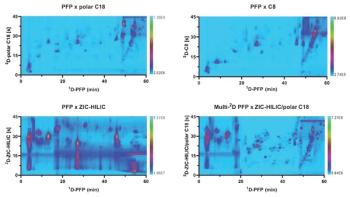Key Points:
- A robust, scalable DBS metabolomics workflow was developed using volumetric absorptive microsampling (VAMS), miniaturized extraction, and dual-column LC–HRMS.
- Miniaturization of the workflow enhanced efficiency while reducing solvent use and manual labor.
- Stability testing confirmed that most metabolites remain reliable in DBS samples stored at room temperature for up to three weeks.
Dried blood spot (DBS) sampling offers a minimally invasive, logistically flexible alternative to venipuncture, and is suitable for remote metabolomics applications. This study presents a high-throughput workflow using volumetric absorptive microsampling (VAMS, 10 µL), miniaturized liquid–liquid extraction in well plates, and dual-column liquid chromatography–high-resolution mass spectrometry (LC–HRMS) for targeted metabolomics. Accurate quantification was enabled by fixed sample volume and yeast-derived fully ¹³C-labeled internal standards. The simplified extraction—shaking and filtration—minimized solvent use and enabled direct LC–HRMS injection. The method was validated using standard reference material (SRM) 1950 human plasma and assessed for DBS stability under room temperature and -80°C storage for 90 days.
The broad applicability of clinical metabolomics is often hampered by the invasive nature and logistical challenges of traditional venous blood collection (1). These traditional methods require clinical expertise, sterile environments, and cold-chain logistics, limiting their feasibility for large-scale or decentralized studies. Dried blood spot (DBS) sampling, originally introduced for neonatal screening (2), offers a compelling alternative. Requiring only a few microliters of capillary blood using a simple finger prick, DBS sampling is minimally invasive, patient-friendly, is not considered a biohazard, and is amenable to remote or self-collection protocols (3). Subsequently, DBS is applied in pediatric and clinical pharmacology, toxicology, forensic science, therapeutic drug monitoring, environmental contaminant tracking, doping control, epidemiology, and global health studies (3).Despite these benefits, the application of DBS in metabolomics is not without technical challenges. One key issue is the control of the blood volume during sampling, which directly impacts quantification accuracy. Innovations such as volumetric microsampling devices—including microfluidic-based tools or volumetric tip microsampling—offer reproducible volume control by ensuring fixed sample sizes. While controlling sample volume is a prerequisite for accurate quantification, there are other aspects inherent to blood sampling, such as the variable proportion of red blood cells in the sampled total blood volume, and matrix-dependent extraction efficiency, which need to be addressed (1). To overcome this challenge, several normalization strategies have been proposed based on hematocrit, hemoglobin, specific gravity, total protein, or potassium (4).
As in any targeted metabolomics study, quantification not only depends on the accuracy of sample intake but also on the calibration strategy. Isotope dilution based on species specific internal (ISTDs) and external standards (ESTDs) is the method of choice for accurate quantification, but comes with the challenge of limited availability and high costs (5). In the ideal case of isotope dilution, the spike material is added as early as possible to the sample. Applied to DBS, this would require the addition of the ISTD to the blood sample prior to the sampling on the DBS material, jeopardizing the simplicity of DBS sampling. Professional help would be needed, and some crucial benefits of DBS would be lost. Applying the ISTD on the DBS device before the sample (6) is broadly excluded as the direct contact of an open wound with the ISTD requires extensive additional experiments certifying the safety as a medical product. Thus, in DBS-based metabolomics, internal standards are added upon extraction.
The difficulty of directly comparing DBS-based analyses to widely used plasma metabolomics presents a fundamental challenge for quantitative metabolomics studies. In fact, the red blood cell (RBC) component introduces a potential bias, challenging the interpretation of data (7). On top of that, upon sampling, the drying process and the subsequent storage (often at room temperature) contribute to the overall uncertainty. Several studies have shown that while many metabolites remain stable for up to three weeks at room temperature, others exhibit significant degradation—especially at elevated temperatures or extended storage times (8–11).Factors such as oxidative degradation, enzymatic activity, and matrix effects all impact stability, increasing uncertainty of quantitative analysis.
This works evaluates a wide-targeted metabolomics approach for DBS, meeting demands for high throughput in large-scale studies. Biotechnologically produced ¹³C-labeled internal standards were foundational to achieving accuracy, allowing seamless integration during extraction. Controlling the DBS sampling and storage stability is essential for broader applications where minimally invasive methods and remote sampling offer significant advantages.
Methods
Sample Collection and Extraction
For stability testing, pooled human whole blood (Innovative Research) was applied on a volumetric absorptive microsampling (VAMS) device (Trajan). The Mitra tips were dried for 24 h to ensure biosafety. Accuracy assessment was conducted with a standard reference material (SRM) 1950—Metabolites in Frozen Human Plasma—from NIST, also on the VAMS device.
For metabolite extraction, 200 µL of a pre-mixed solution (water, liquid chromatography–mass spectrometry [LC–MS]-grade acetonitrile, and fully ¹³C-labeled yeast extract ISO1 from ISOtopic Solutions; 50:140:10, v/v/v) was added to filter plates (Whatman 7720-7236, Cytiva) positioned on WebSeal well plates (350 µL, round well, Thermo). Mitra tips were inserted, sample positions recorded, and plates shaken (700 RPM, 15 min, 20 °C) before the filtration was accomplished via mild centrifugation (1000 RPM, 1 min, 20 °C; Hermle Z446 K). Filtrates were sealed (WebSeal CLR, Thermo Fisher Scientific) and stored at 4 °C until analysis.
Dual Liquid Chromatograph–Mass Spectrometry (LC–MS)
A Vanquish Duo UHPLC system (Thermo Fisher Scientific) was used to perform dual-mode chromatography—hydrophilic interaction liquid chromatography (HILIC) and reversed-phase (RP)—following the setup described by Schwaiger et al.(12). The system used dual injectors, binary pumps, and columns routed via six-port valves to a shared electrospray ionization (ESI) source. Injections were sequenced: HILIC at 0 min and RP at 11 min, with valve switching at 12 min, allowing the idle column to re-equilibrate. Total run time was 27 min.
HILIC was performed on a 150 × 2.1 mm, 1.7-µm BEH Amide column (Waters) with pre-column and eluents consisting of (A) water with 10 mM ammonium formate and 0.125% formic acid, and (B) 95:5 acetonitrile–water with the same additives. A stepped gradient (0–12.75 min) was applied with flow rates of 0.4 mL/min during HILIC and 0.05 mL/min during RP.
RP-LC used a 150 × 2.1 mm, 1.8-µm HSS T3 column (Waters), with eluent A as water + 0.1% formic acid and eluent B as 95% acetonitrile in A. The autosampler and column oven were maintained at 4 °C and 45 °C. Gradient: 0–13 min 0% B, ramping to 100% by 24 min. Flow rates were 0.25 mL/min for RP and 0.05 mL/min during HILIC.
High-resolution mass spectrometry (HRMS) was conducted using a Q Exactive HF Hybrid Quadrupole-Orbitrap (Thermo Fisher Scientific) with electrospray ionization. Settings included: sheath gas 50, auxiliary gas 14, spray voltage 2.8 kV (negative) and 3.5 kV (positive), capillary temperature 270 °C, S-Lens RF 45, and auxiliary gas heater 380 °C. Full scans were acquired in profile mode from m/z 60–900, at a resolution of 120,000 (m/z 200), with an automatic gain control (AGC) target of 1 × 10⁶ and a max injection time of 200 ms.
Data Evaluation
Metabolites were identified at Level 1 by matching retention times and spectra to reference standards; unresolved isomers (hexoses) were reported as summed signals. Data processing was done in Skyline (v24.1) using mzML files converted via MSConvert, integrating both external (ESTDs) and ¹³C-labeled internal standards (ISTDs), with manual adjustment of peak boundaries. ISTDs with ≥90% signal loss (vs. blanks) were excluded. Final data were exported as CSVs and further processed in R/RStudio following Schoeny et al.(13), including blank subtraction, quality control (QC) checks, and filtering by variability (area relative standard deviation [RSD] <30%, retention time [RT] RSD <3%). Quantification was performed using multi-point calibration, normalizing ESTDs to their ISTDs in line with FDA guidelines.
Results and Discussion
High-throughput Sample Preparation
In this study VAMS tools were used as DBS tools because accurate quantification requested a volume-controlled sampling technique. To scale-up the liquid–liquid extraction protocol to high sample numbers, a parallel extraction was implemented (see Figure 1). To increase the throughput, sample preparation steps were decreased to a minimum compared to established protocols (11), requiring the addition of extraction solvent, sample tips, shaking, and filtration (see Figure 1). More specifically, extractions were performed in a well plate format, using protein precipitation plates with a leak-free design for filtration. The solvents were retained in the well until positive pressure, vacuum, or centrifugal force was applied. For extraction, the tips were submerged in 70% acetonitrile for 15 min at room temperature containing yeast-derived fully 13C labeled internal standards (14). This mixture of over 90 labeled compounds was used for multipoint internal standardized external calibration, as recommended for accurate quantification (15).
This workflow was designed to be flexible, easily adopted to different study sizes and degrees of automation. By omitting filter plates, for example, the filtration step can be replaced by centrifugation of well plates followed by transfer of the supernatant. Its overall simplicity supports the adoption of sample handling robots, allowing further upscaling, but increasing overall costs (Figure 2a). In this work, the resulting metabolite extract (70% acetonitrile, 30% water) was analyzed directly without further processing. While the solvent composition was ideally suited for HILIC analysis, in reversed phase chromatography, the chemical space was limited to metabolites showing a high retentivity under these conditions.
Applying VAMS enabled miniaturization because only 10 µL of whole blood was collected. Subsequently, the whole extraction was miniaturized accordingly, with a final solvent volume of 200 µL. In this volume regime, evaporation of solvent significantly impacted quantification accuracy. Closed vessel formats are essential. For well plates, cover foils proved to be fit for purpose, avoiding evaporation. In addition, the relatively short preparation times of 15 min decreased the risk of evaporation (see Figure 2b). The extraction time was optimized by studying the extraction efficiency for different durations up to 2 h using targeted metabolomics by isotope dilution. Finally, the extraction efficiency was not increased by additional sonication (see Figure 2c).
Method Performance
To evaluate the analytical performance and potential biases introduced during extraction, SRM 1950 – Metabolites in Frozen Human Plasma (NIST) (16) was used as a reference material applied onto VAMS tips. A 10 µL measure of SRM 1950 was dispensed onto each tip, dried, stored at -80°C, and analyzed within different batches. Certified reference values for selected amino acids, vitamins, hormones, and clinical markers were available, alongside indicative values useful for method development—the latter not being issued by a metrological institution and not traceable to the International System of Units (SI) (17–18).
In total, 18 out of the 90 quantified compounds could be validated by the certified reference material. Across seven analytical batches (see Figure 3), key metabolites such as amino acids, urea, creatinine, and cortisol were quantified. Most amino acids agreed within their respective confidence intervals, supporting that the analytical process—including volume-controlled sampling, the extraction protocol, and the standardization approach—was fit-for-purpose for wide targeted metabolomics. A number of metabolites, however, such as alanine, cortisol, creatinine, methionine, and urea, showed high variability across batches. Alanine quantification was hampered by the presence of isomers and in-source fragmentation (from creatine), while cortisol, creatinine, methionine, and urea lacked compound-specific internal standards and were quantified via external calibration only, underlining the critical role of internal standards for accurate quantification. Glucose and urea showed mM concentrations in blood. For glucose the calibration range was expanded to higher concentrations for batch 3–7, emphasizing the importance of matching calibration ranges appropriately in metabolomics workflows.
While the extraction and analytical process were shown to perform adequately using plasma-derived SRM material, it was important to emphasize that DBS sampling inherently introduces additional variables that cannot be fully controlled. Unlike plasma, DBS samples contain a mixture of plasma and cellular components (for example, red blood cells, leukocytes), which impact metabolite profiles. Two major bias sources exist in DBS techniques: (i) sample coagulation and blood cell disruption, which may alter metabolite concentration compared to plasma, and (ii) drying and re-extraction processes, which can cause differential recovery of certain analytes. While coagulation effects have been partially investigated by comparing DBS and plasma samples from the same individuals (9,19–21),the intrinsic differences between plasma and whole blood remain. Thus, while DBS can reproduce certain metabolomic patterns seen in plasma, they must still be treated as different sample matrices with their own biological and technical variability.
Therefore, when applying VAMS or DBS sampling in metabolomics studies, it was crucial to differentiate between biases introduced by the analytical process (which can be minimized and validated using SRM materials) and those inherent to the biological nature of DBS sampling, which require careful interpretation of results.
Stability Assessment
Stability assessment in DBS metabolomics is key. Several reports (8–11)on stabilities at room temperature exist, scrutinizing storage times ranging from days to several months post-collection. In this study, storage times of up to 90 days were tested at two temperatures, using a commercially available pooled whole blood sample. A total of 90 compounds from various metabolite classes—including amino acids, organic acids, acylcarnitines, carbohydrates, hormones, vitamins, nucleobases, and others—were monitored for stability (see Table I). Each compound’s internal standardized signal at various storage durations was compared to its signal after one day of storage, which represents the minimum required drying time for VAMS.
Importantly, the majority (62) of the compounds showed changes of less than 30% for the whole period of 90 days stored both at room temperature or -80 °C compared to day 1. At -80°C, only nine compounds showed changes > 30% (ATP, biotin, cysteic acid, cysteine, cytosine, inosine, malic acid, n-methylhydantoin, and phosphoglyceric acid), highlighting the benefit of low storage temperatures for DBS samples.
The best compromise was found to be storage at room temperature for a maximum of three weeks, thus accommodating feasible transport, storage, and measurement times for medium scale studies (see Table I). Twelve compounds were found with changes > 30%. Generally, sulfur-containing substances showed very limited storage stability even after seven days (S-adenosyl methionine, cysteine, cysteate, see Figure 4). Measuring and interpreting purine metabolites in DBS experiments is challenging (8–11) because these compounds mainly stem from erythrocytes. In this study, the nucleotides (AMP, ADP, ATP, GDP, GTP) decreased during storage but their possible degradation products did not increase; adenine even decreased at a similar degree (see Figure 5). Ongoing enzymatic activity may account for the observed changes. Similarly, the compound with the highest increase, aminoadipic acid, showed an increase by a factor of 6 after 21 days and even 16 after 90 days. Belonging to the lysine degradation pathway, this might be indicative of protein degradation. Finally, argininosuccinic acid, ornithine, phosphoglyceric acid, cytosine, and nicotinamide also showed a limited stability after 21 days at room temperature.
Conclusion
This study establishes a scalable and high-throughput workflow for the wide targeted metabolomics from DBS utilizing VAMS and a dual-column LC–MS setup. Deriving from the need for precise and minimally invasive sampling, VAMS proved effective in enabling volume-controlled collection, crucial for accurate DBS analysis. By integrating a parallel extraction in a well-plate format and minimizing procedural steps to shaking and filtration (or centrifugation), the workflow significantly reduced manual workload without compromising analytical performance.
The incorporation of yeast-derived fully ¹³C-labeled internal standards throughout the extraction and measurement process further enhanced accuracy and corrected for potential losses, which is particularly critical in miniaturized and evaporation-prone formats. Stability testing confirmed the validity of DBS metabolomics for most target molecules over three weeks of storage at room temperature, supporting the feasibility of remote sampling and transport. Accuracy assessment using the SRM 1950 reference material revealed high agreement for several key metabolites, while also underlining the need for compound-specific internal standards.
Taken together, this approach offers a reliable and efficient platform for wide-targeted metabolomics using DBS, paving the way for broader application in clinical and field-based studies where sample integrity, throughput, and minimal invasiveness are paramount.
Acknowledgment
This work was supported by the University of Vienna, the Faculty of Chemistry and Centre for Sport Science and University Sports. The authors thank all members of the Koellensperger lab (University of Vienna) group and the Österreichisches Institut für Sportmedizin (ÖISM) for continuous support.
References
(1) Thangavelu, M. U.; Wouters, B.; Kindt, A.; Reiss, I. K. M.; Hankemeier; T. Blood Microsampling Technologies: Innovations and Spplications in 2022. Analytical Science Advances 2023, 4, 154–80. DOI:10.1002/ansa.202300011
(2) Guthrie, R.; Susi, A. A Simple Phenylalanine Method for Detecting Phenylketonuria in Large Populations of Newborn Infants. Pediatrics 1963, 32, 38–43.
(3) Thevis, M.; Walpurgis, K.; Thomas, A. DropWise. Current Role and Future Perspectives of Dried Blood Spots (DBS), Blood Microsampling, and their Analysis in Sports Drug Testing. Crit. Rev. Clin. Lab. Sci. 2022, 60(1), 41–62. DOI: 10.1080/10408363.2022.2103085
(4) Jain, A.; Morris, M.; Lin, E. Z.; et al. Hemoglobin Normalization Outperforms Other Methods for Standardizing Dried Blood Spot Metabolomics: A Comparative Study. Sci. Total Environ. 2023, 854,158716. DOI: 10.1016/j.scitotenv.2022.158716
(5) Rampler, E.; El Abiead, Y.; Schoeny, H.; et al. Recurrent Topics in Mass Spectrometry-Based Metabolomics and Lipidomics—Standardization, Coverage, and Throughput. Anal. Chem. 2021, 93, 519–545. DOI: 10.1021/acs.analchem.0c04698
(6) Meesters, R.; Hooff, G.; Van Huizen, N.; Gruters, R.; Luider, T. Impact of Internal Standard Addition on Dried Blood Spot Analysis in Bioanalytical Method Development. Bioanalysis 2011, 3, 2357–64. DOI: 10.4155/bio.11.202
(7) Tobin, N. H.; Murphy, A.; Li, F.; et al. Comparison of Dried Blood Spot and Plasma Sampling for Untargeted Metabolomics. Metabolomics 2021, 17, 62. DOI: 10.1007/s11306-021-01813-3
(8) Cui, H. N.; Shi, F.; Huang, G.; et al. Evaluation of Metabolite Stability in Dried Blood Spot Stored at Different Temperatures and Tmes. Sci. Rep. 2024, 14, 30964. DOI: 10.1038/s41598-024-82041-2
(9) Volani, C.; Malfertheiner, C.; Caprioli, G.; et al. VAMS-Based Blood Capillary Sampling for Mass Spectrometry-Based Human Metabolomics Studies. Metabolites 2023, 13, 146. DOI: 10.3390/metabo13020146
(10) Trifonova, O. P.; Maslov, D. L.; Balashova, E. E.; Lokhov, P. G. Evaluation of Dried Blood Spot Sampling for Clinical Metabolomics: Effects of Different Papers and Sample Storage Stability. Metabolites 2019, 9, 277. DOI: 10.3390/metabo9110277
(11) Volani, C.; Caprioli, G.; Calderisi, G.; et al. Pre-analytic Evaluation of Volumetric Absorptive Microsampling and Integration in a Mass Spectrometry-based Metabolomics Workflow. Anal. Bioanal. Chem. 2017, 409, 6263–76. DOI: 10.1007/s00216-017-0571-8
(12) Schwaiger, M.; Schoeny, H.; Abiead, Y. El.; et al. Merging Metabolomics and Lipidomics Into One Analytical Run. Analyst 2019, 44,220–229. DOI: 10.1039/c8an01219a
(13) Schoeny, H.; Rampler, E.; Abiead, Y. El;et al. (2021). A Combined Flow Injection/Reversed Phase Chromatography-High Resolution Mass Spectrometry Workflow for Accurate Absolute Lipid Quantification With 13C-Internal Standards. Analyst 2021, 146, 2591–2599. DOI: 10.1039/d0an02443k
(14) Hermann, G.; Schwaiger, M.; Volejnik, P.; Koellensperger, G. 13C-labelled Yeast as Internal Standard for LC –MS / MS and LC High Resolution MS Based Amino Acid Quantification in Human Plasma. J. Pharm. Biomed. Anal. 2018, 155, 329–34. DOI: 10.1016/j.jpba.2018.03.050
(15) FDA, Guidance for Industry, Bioanalytical Method Validation (CDER, 2001).
(16) Gonzalez, C. A.; Choquette, S. J. Standard Reference Material 1950 Metabolites in Frozen Human Plasma CERTIFICATE OF ANALYSIS [Internet]. 2023. Available from: https://tsapps.nist.gov/srmext/certificates/1950.pdf (accessed 2025-05-30).
(17) Thompson, J. W.; Adams, K. J.; Adamski. J.; et al. International Ring Trial of a High Resolution Targeted Metabolomics and Lipidomics Platform for Serum and Plasma Analysis. Anal. Chem. 2019, 91, 14407–14416. DOI: 10.1021/acs.analchem.9b02908
(18) Mandal, R.; Zheng, J.; Zhang, L.; et al. Comprehensive, Quantitative Analysis of SRM 1950: the NIST Human Plasma Reference Material. Anal. Chem. 2025, 97, 667–75. DOI: 10.1021/acs.analchem.4c05018
(19) Denery, J. R.; Nunes, A. A. K.; Dickerson, T. J. Characterization of Differences Between Blood Sample Matrices in Untargeted Metabolomics. Anal. Chem. 2011, 83, 1040–1477. DOI: 10.1021/ac102806p
(20) Tobin, N. H.; Murphy, A.; Li, F.; et al. Comparison of Dried Blood Spot and Plasma Sampling for Untargeted Metabolomics. Metabolomics 2021, 17, 62. DOI: 10.1007/s11306-021-01813-3
(21) Wickremsinhe, E. R.; Huang, N. H.; Abdul, B. G.; et al. Preclinical bridging Studies: Understanding Dried Blood Spot and Plasma Exposure Profiles. Bioanalysis 2013, 5, 159–70. DOI: 10.4155/bio.12.309
Harald Schoeny is a senior scientist at the Department of Analytical Chemistry, University of Vienna. He is a member of the Koellensperger Lab, where he focuses on advancing analytical methodologies in metabolomics and lipidomics. His contributions to analytical chemistry have advanced the field’s capabilities in precise and high-throughput analysis, with a special focus for applications in sport science.
Bruno Stelzer is a graduate student who works as a technician in Gunda Koellensperger’s group at the University of Vienna. With a background in mechanical engineering, he developed a strong interest in analytical instrumentation and mass spectrometry.
Gunda Koellensperger is a distinguished Austrian chemist and full professor of analytical chemistry at the University of Vienna. She serves as vice dean of the Faculty of Chemistry and deputy head of the Department of Analytical Chemistry. Her research centers on advancing analytical techniques in metallomics, metabolomics, and mass spectrometry. She has significantly contributed to the development of high-throughput methods in biological samples and is actively involved in single-cell analysis and spatial biology. Her contributions have been recognized with several awards, such as the Houska Prize in 2017.





